Turtles make for great pets and are very rewarding to keep. However, finding the best pet turtle for your situation is vital to your success as a reptile keeper. Turtles come in all shapes and sizes and this list of the best pet turtles contains just some of the species that make for great pets.
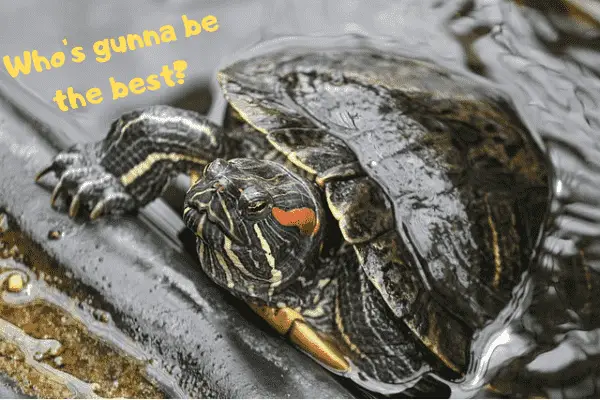
Table of Contents
What to look out for when buying a pet turtle
There are a few things you need to keep in mind when buying a pet turtle. Below, we’ve listed just some of the important things to keep in mind to help you make this right decision and find the best pet turtle for you.
- Size
The size that your turtle becomes can make their husbandry a lot harder. A lot of people end up having to get rid of their tortoise because they outgrow their enclosures, so try to think about this before you buy one. Certain turtle species can get quite big, so it’s best to go with a smaller species if you don’t have the space.
- Hardiness
While there are a lot of hardy turtle species, there are also many species that are sensitive to water conditions, temperature, or other variables. If you’re inexperienced or don’t have the funds/knowledge, it’s best to go with a turtle that’s hardy and more forgiving to small mistakes and fluctuations.
- Appearance and company
Appearance isn’t everything, but for a display animal like a turtle that lives for a long time, it sure does help if you enjoy its company. Get a turtle that you’d enjoy caring for for some time to come and take the time to think about the responsibility you will have once you get one.
Now we’ve got that out of the way, its time to get into the list of the best pet turtles. Below you’ll find some of the best turtles to keep as pets, along with a little information about their care.
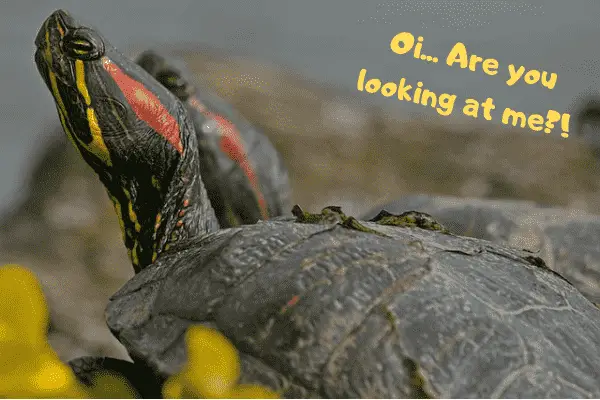
Red-eared slider
Size: Medium (Up to 12 inches)
Care: Easy if you know what you’re doing. Great for outdoors in warmer climates
Hardiness: These pet turtles are hardy and forgiving to accidental mistakes
The first on the list is one of the most common turtles you’ll see in pet stores. The red-eared slider is a very common turtle, and certainly one of the best pet turtles if you have the space for them. These turtles can grow to quite large sizes and are normally housed outside as they get older.
These turtles are very hardy and make for great pets. Their large size means they need a large enclosure and are a little more expensive to care for than some of the other options on this list. They are extremely easy to find and make for great pets.
They are omnivores and enjoy foods ranging from vegetation all the way to small fish. Depending on where you live, you can actually view these turtles in the wild. They have a few natural enemies, mostly small to medium-sized mammals, like racoons and otters.
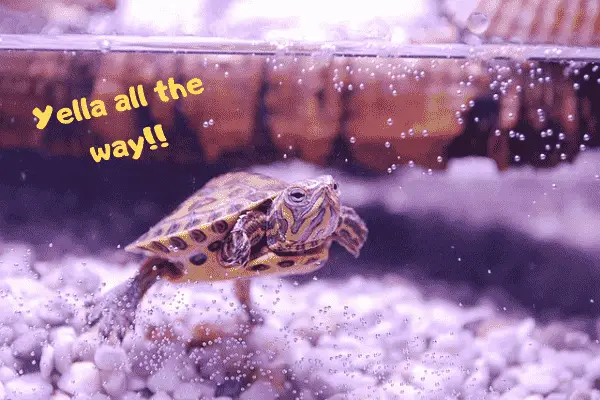
Yellow belly slider
Size: Medium (Up to 11 inches)
Care: Easy with proper research. Great as outdoor pets in warmer climates
Hardiness: A hardy pet turtle.
The second on this list is the yellow belly slider, and it’s a lot like the red-eared slider in many ways. They are also extremely common and easy to find but also come with the disadvantage that they grow to quite large sizes compared to some of the other turtles on this list.
These turtles can actually live for up to 30 or 40 years, so if you do go for a yellow belly slider, make sure that you’re prepared to care for them for a long time. They also eat a variety of different animals and plants, but their diet consists mainly of small animals like insects and fish.
The yellow belly slider is easy to care for and is a great pet if you have the room for them.
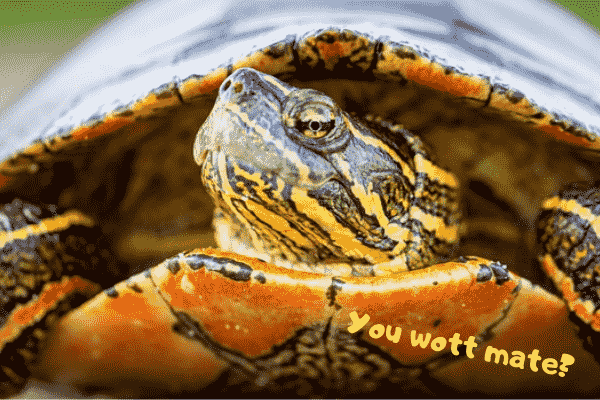
Painted turtle
Size: Small (Up to 7 inches)
Care: Easy with proper research
Hardiness: A forgiving turtle species to small mistakes along the way
The painted turtle is another great pet turtle, and it’s one that’s more suitable for people with less space. These turtles are small and can be kept in an aquarium that’s about 75 gallons. This means that they can be kept inside and it’s much easier to regulate their environment.
These turtles are also quite hardy and make for great pets if you are less experienced. With the right research, you can provide the correct husbandry and shouldn’t experience too much trouble as they grow up.
These turtles are easy to find and are relatively inexpensive to purchase and maintain. They look fantastic and it’s very easy to find information about their care online.
Musk turtle
Size: Small (2-5 inches or 5 to 12 cm)
Care: Easy if husbandry is properly researched first
Hardiness: Reasonably hardy if provided with the right care
Next is the musk turtle, and as the name might suggest these animals can let off quite the stench when they feel threatened. Luckily, they get used to their owners quite quickly and you shouldn’t experience this too often if you go for a musk turtle.
These turtles are also very small and make for great indoor display animals. They are a little less hardy than the painted turtle, but with the right research, they can be cared for properly without too much trouble.
In the wild, these turtles can be examined in various aquatic landscapes across the east of the US. They are also nocturnal which may make them hard to spot in the wild. Since they are most active at night, these pets are great for people who are out and about for most of the day.
Musk turtles are easy to find in local aquariums or pet shops and finding information on their care is pretty straight forward online. They can live for up to 50 years and you’ll therefore be able to enjoy their company for a very long time!
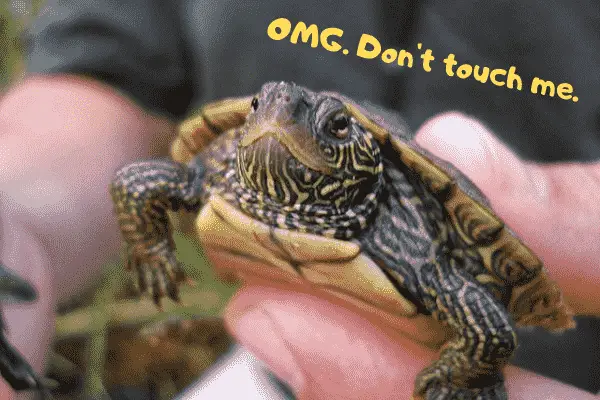
Map turtle
Size: Medium (4-10 inches, or 10-27 cms)
Care: Doable, but more challenging than the previous pet turtles
Hardiness: These turtles are a little less forgiving of mistakes
The map turtle is the next turtle on this list and it’s another fantastic pet turtle that’s suitable to less experienced turtle keepers. They are a little harder to care for than the previous turtles on this list, but with some minor experience in keeping turtles and a lot of research, providing the right husbandry is doable.
One other thing that complicates the matter is that the females can get rather large. This means that if you don’t have a lot of space, it may be best to go for the smaller male instead of a female.
In the wild, these turtles can be seen all across the north-east of the US, in larger bodies of water. They are very secretive, and people have a hard time finding them in the wild. This is one of the reasons why owning one as a pet is so much fun! It gives you the chance of learning more about a secretive reptile.
Wood turtle
Size: Medium (5-8 inches, or 14 to 20 cms)
Care: Doable with the right research
Hardiness: Reasonably hardy if kept away from other animals
Second to last is the wood turtle, a friendly turtle species that’s a lot of fun as a pet. They are also a little larger but can be kept in normal-sized enclosures for the first few years. After this, they should be moved outdoors, or provided with a larger enclosure that may not be ideal for everyone.
These turtles are relatively hardy as long as you stay on top of their husbandry and don’t introduce them to other animals. They are quite susceptible to diseases carried by other animals, so this is something to look out for.
Wood turtles are a little trickier to find and actually illegal to keep as pets in many places. When buying any reptile, make sure to check whether it’s legal to keep them as pets where you live!
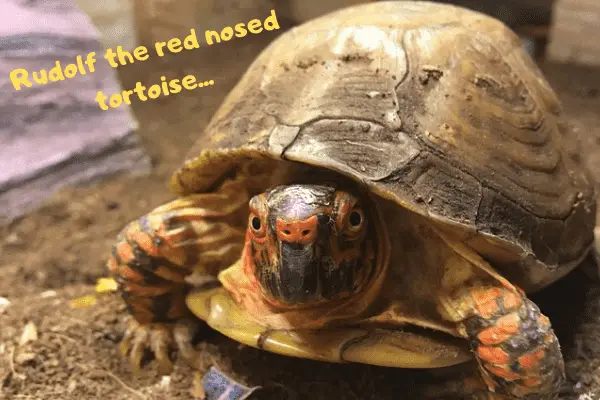
Eastern box turtle
Size: Medium (4-7 inches, or 10-18cm’s)
Care: Easy if proper research is done beforehand
Hardiness: Good if you manage to find a captive-bred individual
Last on the list is the eastern box turtle. This is a species of turtle that’s slightly smaller than the previous one but does come with its own things to look out for.
One of the main things is where you buy these animals. Often, they are wild-caught so that’s not ideal when it comes to parasites and disease, as well as the wild populations. This also causes a lot of the readily available ones to be malnourished and difficult to nurse back to health.
That being said, once you have an eastern box turtle that is doing well, you’ll certainly get a lot of enjoyment out of them. They make for great pets and are a good option for people with a little more experience keeping turtles.
Conclusion
As you can see, there are a lot of great pet turtles, and finding the best pet turtle for you can be a challenge. We hope that this article has helped you in the research process and has pointed you in the right direction.
If there’s anything you feel we’ve missed, or you have any questions or comments then please feel free to leave a comment or shoot us a message. We’re always looking to improve the resources we offer.
